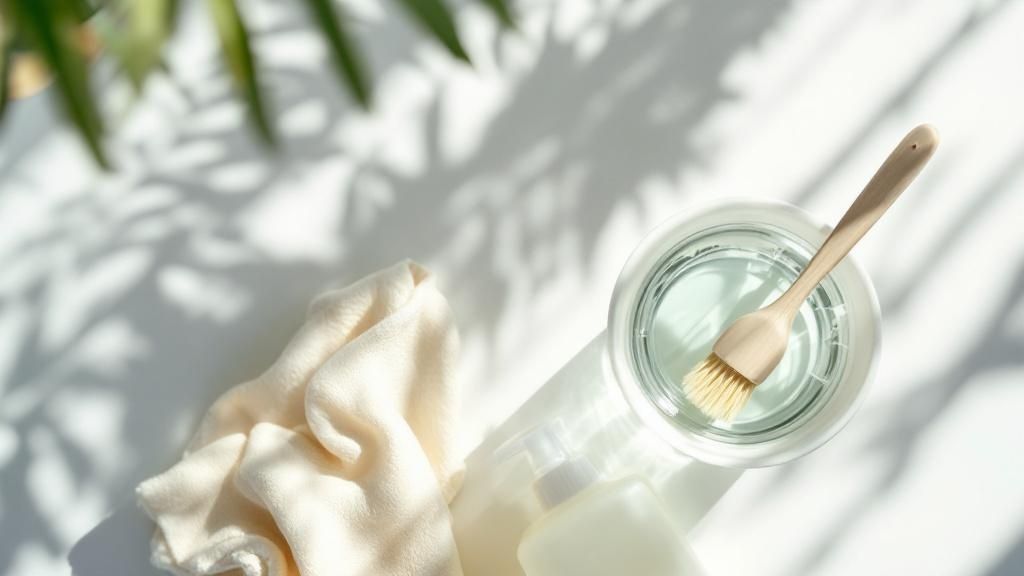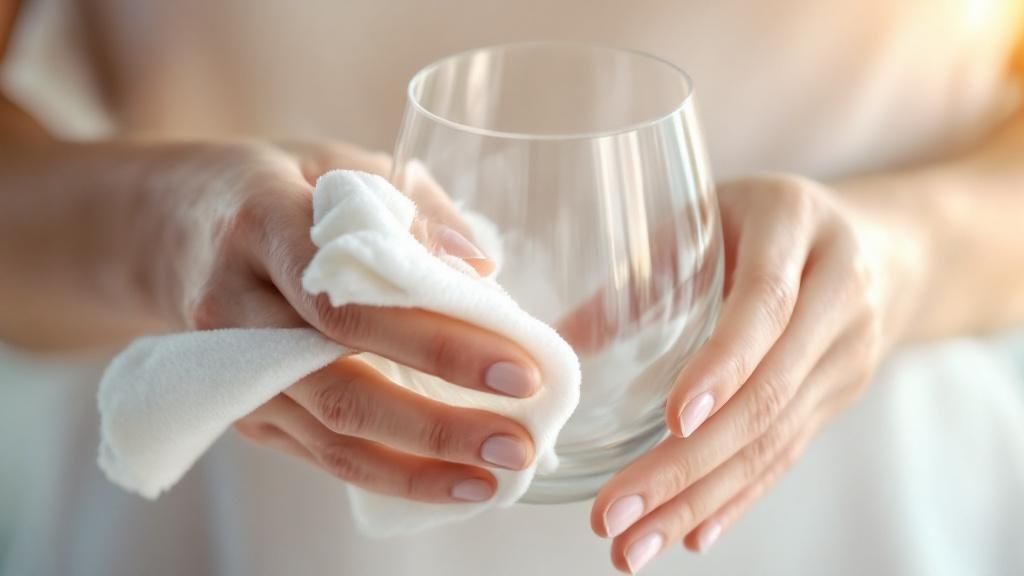Know Your Crystal Before You Touch It
 Before a drop of water touches your glassware, it’s worth taking a moment to appreciate what you’re about to clean. Not all gleaming glass is created equal, and understanding the difference between true lead crystal and its modern counterparts is your first step to a flawless finish. This isn't just trivia for antique lovers; it directly impacts how you handle each piece to prevent scratches or cracks.
Before a drop of water touches your glassware, it’s worth taking a moment to appreciate what you’re about to clean. Not all gleaming glass is created equal, and understanding the difference between true lead crystal and its modern counterparts is your first step to a flawless finish. This isn't just trivia for antique lovers; it directly impacts how you handle each piece to prevent scratches or cracks.
The primary difference lies in the material's makeup. Traditional lead crystal, a discovery credited to George Ravenscroft around 1674, contains between 18% to 30% lead oxide. This addition is what gives the glass its signature heft and dazzling brilliance. However, it also makes the material softer and more porous, leaving it vulnerable to sudden temperature changes and scratches. You can learn more about the history and market for these items by exploring the evolution of glass cleaners and their applications.
Telling the Difference: A Quick Guide
So, how do you figure out what you have in your hands? You don't need a science lab—just a few simple, hands-on tests.
- Weight and Feel: Pick it up. Real lead crystal has a noticeable weight and density compared to a regular glass of the same size. It just feels more substantial.
- The Sound Test: Gently tap the rim of the glass with your fingernail. Lead crystal emits a clear, sustained ringing tone—a lovely "ping" that lingers. Standard glass will just give you a dull, short "clink."
- Prism Effect: Hold the glass up to a window or a light. The high refractive index of lead crystal will act like a prism, splitting the light into a beautiful little rainbow of colors.
Inspect for Pre-Existing Damage
After identifying your type of crystal, give each piece a careful inspection under good lighting. You're looking for tiny chips along the rim, hairline fractures, or any "sickness"—a milky or foggy look that often signals permanent damage. Knowing a piece is already fragile is a crucial reminder to be extra gentle when you begin the cleaning process. Think of this initial check as creating a game plan to keep your beautiful glassware safe.
Your Crystal Cleaning Arsenal: What Really Works

If you think your everyday glass cleaner will do the trick for crystal, it's time for a rethink. Your fine crystal deserves a dedicated set of tools. Assembling the right cleaning kit isn't about spending a lot; it's about choosing gentle, effective items that will protect the delicate surface and maintain its brilliance. When figuring out how to clean crystal glasses, the most critical rule is to avoid harsh chemicals and abrasive materials completely.
The Right Soap and Water
The journey to a brilliant shine begins with the most basic elements: soap and water. You'll want to grab a mild, scent-free dish soap—seriously, just a few drops are enough. Soaps with heavy perfumes or dyes often contain extra additives that can leave a frustrating film on your crystal, which dulls its sparkle.
Equally important is the water temperature. Always, always use lukewarm water. Extreme temperatures, whether hot or cold, can cause thermal shock. This can lead to tiny, invisible fractures or, in a worst-case scenario, a complete break. This is particularly true for older lead crystal, which is more porous and sensitive to temperature swings. If you're looking to add some modern resilience to your collection, our curated glassware features stunning pieces perfect for any event.
To help you choose the right supplies and steer clear of damaging ones, here’s a quick comparison.
Essential Crystal Cleaning Supplies Comparison
| Supply Type | Recommended Options | Avoid These | Why It Matters |
|---|---|---|---|
| Cleaning Agent | Mild, fragrance-free dish soap; Distilled white vinegar (for stains) | Abrasive powders, ammonia-based cleaners, regular glass cleaners, lemon juice | Harsh chemicals can etch or scratch the crystal's surface, while acidic substances like lemon juice can cause permanent damage. |
| Water | Lukewarm tap or distilled water | Hot or cold water | Extreme temperatures cause thermal shock, which can lead to cracks and breakage in the delicate crystal structure. |
| Drying Cloths | Lint-free microfiber cloths | Paper towels, regular dish towels, air drying | Microfiber dries without leaving lint or causing scratches. Paper towels are surprisingly abrasive, and air drying leads to water spots. |
| Washing Basin | Two plastic or silicone basins | Metal or ceramic sink | Washing in a basin prevents accidental chips and cracks from bumping against hard sink surfaces or the faucet. |
| Brushes | Soft-bristled bottle brush | Stiff-bristled brushes, sponges with scour pads | A soft brush can clean inside narrow decanters and glasses without scratching the interior, unlike abrasive sponges. |
This table shows that gentle is always better. The goal is to lift away grime and oils without compromising the integrity of the crystal.
Essential Tools for a Gentle Clean
Beyond soap and water, a few key tools will make a world of difference in your cleaning process. Your choice of cloths and brushes is significant. Here’s what you’ll need:
- Two plastic wash basins: Why two? One is for washing with soapy water, and the second is for rinsing with clean water. Using basins instead of your sink is a pro tip to prevent accidental chips against a hard faucet or ceramic surface.
- Lint-free microfiber cloths: These are absolutely essential for both washing and drying. They cling to dirt without scratching the glass and, most importantly, won't leave behind a blanket of fuzz. Steer clear of paper towels; their wood pulp fibers can be surprisingly abrasive.
- A soft-bristled bottle brush: For those elegant decanters or tall, narrow-necked glasses, a gentle brush is your best friend. It allows you to clean the inside thoroughly without resorting to risky methods like shaking rice or salt inside, which can easily cause scratches.
The Gentle Hand-Washing Technique That Preserves Beauty
With your cleaning supplies at the ready, it's time to put your careful prep work into action. The real secret to cleaning crystal glasses without causing damage is a gentle, methodical approach, not vigorous scrubbing. Your goal is to be deliberate and handle each piece with confidence, not fear.
The Washing Process: A Gentle Swirl
Start by placing a plastic basin in your sink and filling it with lukewarm water. Add just a few drops of a mild, fragrance-free dish soap—you’re aiming for a slightly sudsy solution, not a bubble bath. To be extra safe, place a folded microfiber cloth at the bottom of the basin to act as a soft cushion.
Always wash one glass at a time. This simple rule prevents them from clinking together, which is a common cause of tiny, heartbreaking chips. Submerge the glass completely, holding it by the bowl rather than the delicate stem. Using another soft microfiber cloth, gently wipe the inside and outside. For a stubborn lipstick mark on the rim, a little focused pressure with the cloth usually does the trick. If you're cleaning a narrow decanter or flute, a soft-bristled bottle brush is perfect for carefully reaching those interior surfaces. Just remember to use a light, swirling motion instead of aggressive scrubbing.
To make the core steps even clearer, this infographic breaks down the essential flow for safely cleaning your crystal.

This visual guide reinforces the three non-negotiable stages: a warm rinse, a gentle wash, and proper air-drying to prevent any damage.
The All-Important Rinse
After washing, it’s time to rinse. Fill your second plastic basin with clean, lukewarm water. Lift the soapy glass from the first basin and submerge it in the rinse water, swirling it gently to wash away all soap residue. Skipping this step is what often leads to a cloudy film, which dulls the crystal’s brilliant sparkle. A thorough rinse in clean water is the key to a spot-free finish.
Never rinse crystal directly under a running faucet. The combination of water pressure and an accidental knock against the metal tap is a recipe for disaster. This controlled two-basin method gives you complete authority over the process, ensuring every piece stays safe and sparkling.
Winning the War Against Water Spots and Mineral Buildup

There’s nothing more disappointing than pulling a freshly washed crystal glass from the rack, only to find it marred by a cloudy, spotty film. This isn't leftover grime; it's the signature of mineral deposits left behind by hard water as it evaporates. The science is simple: when water disappears, minerals like calcium and magnesium stay behind, clinging to the surface. Lead crystal is especially prone to this, as its porous nature gives these minerals more to grab onto. You can find more details on the market trends for crystal glass care.
Dealing with this buildup involves two key actions: getting rid of the existing spots and stopping new ones from ever forming. The good news is you don't need an arsenal of harsh chemicals to do it.
Removing Existing Mineral Stains
If you're facing stubborn cloudiness that regular soap and water couldn't touch, your secret weapon is probably already in your pantry: distilled white vinegar. Its gentle acidity is strong enough to break down mineral deposits but won't damage the delicate crystal.
- The Soaking Method: For an all-over cloudy appearance, submerge the glassware in a 50/50 mix of lukewarm water and white vinegar. Let it sit for about an hour, then give it another gentle wash with mild soap and rinse it well.
- Targeted Application: If you just have a few problem spots, you can apply the vinegar directly. Just dab a small amount onto a microfiber cloth and gently rub the area in a circular motion until the spot dissolves.
This simple household solution is much safer and more effective than abrasive powders or aggressive cleaners that can permanently scratch or etch your glassware.
Advanced Prevention Strategies
Of course, the best way to fight water spots is to prevent them from showing up in the first place. If you know your home has hard water, the single most impactful change you can make is to use distilled water for the final rinse. Since distilled water is mineral-free, it leaves absolutely nothing behind to create spots.
After that final rinse, immediate and thorough drying is essential. Letting crystal air-dry is practically an invitation for water spots to form. Instead, take a clean, lint-free microfiber cloth and gently polish each piece until it is completely dry and gleaming. This final touch is what guarantees that flawless, sparkling finish every single time.
Drying and Polishing Secrets for Museum-Quality Results
You've carefully washed your crystal, but this next phase is where the real magic happens. Drying and polishing are what give your glassware that flawless, brilliant sparkle. It’s the step that separates a decent job from a truly stunning one, and honestly, it's where most people go wrong. The biggest secret? Avoid air-drying at all costs. This is the number one cause of those annoying water spots and mineral rings, especially if your home has hard water.
Choosing Your Polishing Cloth
Put that kitchen towel down! Your regular dish towel is more likely to leave behind a fuzzy layer of lint than to give you a clean shine. For a professional-level finish, you need a high-quality, lint-free microfiber cloth. I actually recommend using two: one for the initial drying and a second, completely dry one for the final polish. This two-cloth method is a game-changer because it ensures you're removing every bit of moisture instead of just smearing it around. Look for a cloth with a smooth texture, not a ribbed one, so it can glide over the delicate surface without snagging.
The Polishing Technique
As soon as a glass is washed and rinsed, it's time to dry it immediately. Hold the glass by the bowl—never the fragile stem—and gently pat the outside dry. Then, carefully dry the inside. For the final touch, grab your second dry microfiber cloth. Use light, circular motions on the bowl and long, gentle strokes on the stem and base.
Here’s a pro tip: polishing the glass while it’s still a little warm from the rinse water helps bring out its natural brilliance. This small detail makes a huge difference when you're learning how to clean crystal glasses for that coveted, museum-quality sparkle.
Navigating Crystal Cleaning Products Like a Pro
Walking down the cleaning aisle can feel like a guessing game, especially with countless products all promising a perfect, streak-free shine. But when you’re figuring out how to clean crystal glasses, you need to look past the marketing claims. The glass cleaner market is massive—valued at $4.4 billion in 2023—and it's only getting bigger. While this means more options, it also increases the chance of picking the wrong product for your delicate pieces. You can get a better sense of where the industry is heading by looking into the latest glass cleaner market trends.
Household Heroes vs. Specialty Cleaners
Even with so many specialty cleaners on the shelves, many seasoned collectors and professionals stick with simple, inexpensive household items. Often, a few drops of a mild, fragrance-free dish soap is all you really need to get the job done. If you're dealing with stubborn mineral buildup or that dreaded cloudiness, a simple mix of 50% white vinegar and 50% warm water works wonders without the harsh chemicals found in many commercial products.
On the other hand, some popular cleaning "hacks" you see online can be a total disaster for crystal. You should never use ammonia-based window cleaners, abrasive powders like baking soda, or anything highly acidic like pure lemon juice. These can permanently etch the delicate surface of your crystal. This gentle-first approach is a smart rule for other fine materials in your home, too. For instance, our guide on how to clean marble follows similar principles for protecting valuable surfaces.
Red Flags to Watch For When Shopping
If you decide to go with a specialty cleaner, always take a moment to read the label carefully. You'll want to find products specifically formulated for lead crystal and steer clear of any that list ammonia, harsh solvents, or abrasive agents in their ingredients. A good rule to follow: if it sounds like something you'd use to strip paint, it doesn't belong anywhere near your treasured glassware.
To help you choose the right product, I've put together a quick comparison table based on my experience. It breaks down the effectiveness and cost of different cleaning options.
| Product Type | Effectiveness Rating | Average Cost | Best Use Case |
|---|---|---|---|
| Mild Dish Soap | ★★★★☆ | $ | Everyday cleaning and light grime removal. |
| White Vinegar/Water | ★★★★★ | $ | Removing tough mineral deposits and cloudiness. |
| Specialty Crystal Cleaner | ★★★★☆ | $$$ | Restoring brilliance to high-end, intricate pieces. |
| Ammonia-Based Cleaner | ★☆☆☆☆ | $$ | Not recommended for crystal; can cause etching. |
This table shows that the best investment is often the simplest one. Gentle soap, soft cloths, and a little bit of care will give you that beautiful, museum-quality sparkle without putting your crystal at risk. The long-term beauty of your glassware really depends on making these careful choices.
Key Takeaways
Knowing how to clean crystal glasses isn't about mastering a complicated skill; it's about forming simple, reliable habits. When you treat it as a quick routine rather than a dreaded chore, you protect your beautiful collection without a second thought. By creating a straightforward plan for care, the whole process becomes second nature, keeping your glassware brilliant for every occasion.
Realistic Maintenance Schedules
When it comes to crystal, consistency is your best friend. A simple, practical schedule stops grime and stains from ever becoming a problem, which means you'll rarely need to do a heavy-duty deep clean.
- Daily Care: If you've just enjoyed a glass of wine, a quick rinse under lukewarm water is usually all it takes to wash away any residue. This takes less than a minute and is the single best way to prevent stains from settling in.
- Weekly or Occasional Use: For glasses that you don't use every day, follow the full gentle hand-washing method we covered earlier. This keeps them sparkling and free of dust, so they're always ready for your next dinner party or quiet evening in.
- Deep Cleaning (Annually or as Needed): That vinegar soak we talked about? Think of it as a special treatment. Only bring it out when you start to see that tell-tale cloudiness from hard water or mineral buildup. It’s a restorative measure, not part of the regular wash cycle.
Proper Storage and Handling
How you store your crystal is just as important as how you clean it. The wrong storage can easily undo all your hard work, leading to dust, chips, or even scratches.
- Cabinet Choice: A closed-door cabinet is the ideal home for your crystal. It shields your glasses from the enemies of sparkle: dust and airborne kitchen grease. While open shelving can look beautiful, it means you'll be cleaning your glasses much more often.
- Positioning: Always store your glasses standing upright on their base. It might be tempting to store them rim-down to keep dust out, but this can trap moisture inside and puts unnecessary pressure on the most fragile part of the glass.
- Spacing: Give them some breathing room! Crowding glasses together is an invitation for them to clink and chip when you reach for one. For any long-term storage or if you're moving, take the extra step to wrap each piece individually in a soft cloth or bubble wrap.
Making these small steps part of your routine turns crystal care from a task into a habit. And if you're thinking of adding a new piece to your collection or finding a thoughtful present, you might discover the perfect thing in our curated selection of elegant housewarming gifts.

